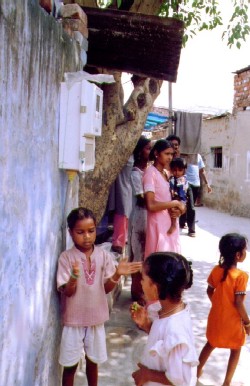You are here » Home » Telling Our Story
Case Study
A dependable supply of electricity has revitalized poor neighborhoods in Ahmedabad
Electricity Benefits Poor Neighborhoods

| |
Photo: USAID/Virginia Foley
|
|
Households in Ahmedabad's poorest neighborhoods now pay less for a more dependable electricity supply.
Reliable electricity allows family members to work or study in the evening, increasing productivity and earning potential.
|
Challenge
Historically, families in India's poorest neighborhoods could only receive electricity if the household proved legal residency and guaranteed that it could cover the cost of distribution. But very few poor households can prove ownership; even fewer can raise the upfront costs of connecting to a grid. About 40 percent of homes in poor neighborhoods have illegal power connections, but the supply is undependable and costs twice as much as a legal connection; consequently, utilities have 40 percent energy losses in these neighborhoods. The lack of electricity also meant that women spent their daylight hours laboring over menial chores that could have been greatly eased with dependable access to power.
Initiative
With the Ahmedabad Electric Company and local organizations, USAID helped plan a system to provide safe and reliable electrical service for 1.2 million people in Ahmedabad's poorest neighborhoods. After the program's initial success in providing high-quality, reliable service, local organizations were so pleased that they used their own funds to expand the program to another 30,000 households and aim to provide service to 200,000 more poor customers by 2007.
Results
Once poor neighborhoods had legal access to electricity, losses from theft were eliminated, and households paid less money for more reliable service. And reliable service means that family members can now work or study in the evenings, using sewing machines and other appliances to increase productivity and earning potential. The higher quality power service reduced damage to domestic electrical equipment and expanded access to leisure activities, including watching television. Many women now earn incomes by reading meters for the utilities, and community associations and organizations generate revenue by giving loans for start-up connection charges. Most importantly, utility company staff and residents of the poor neighborhoods have developed a mutual trust, allowing for effective utility-customer interaction - and the chance for more improvements in the future.
Print-friendly version of this page (40kb - PDF)
Click here for high-res photo
Back to Top ^ | 

